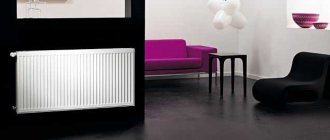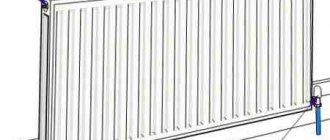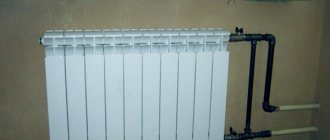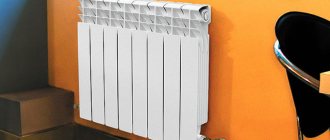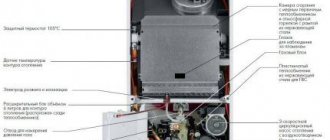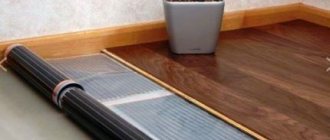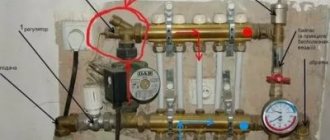What distinguishes a convector from a radiator
The described devices are a type of heating devices. They can work independently or as elements of a heating system. The main difference between a convector and a radiator is the design and operating principle of the devices.
Radiator
It is a unit with a sectional metal body. All free space in the sections is filled with coolant. Water, special mineral oil or antifreeze liquid are used as a coolant.
The operating principle of the unit is based on the thermal radiation method. Under the influence of a heat source, the coolant is heated. This source is the heating element.
An increase in coolant temperature leads to heating of the surface of the device body. The heated body releases heat into the surrounding space. Under the influence of thermal radiation, the heating level in the room increases.
The coolant temperature is monitored by a built-in thermal sensor. Automation turns the device on and off when the set values are reached. The heating of the working fluid is controlled using a built-in thermostat.
Convector
To answer how a heating convector differs from a radiator, let’s consider the operating principle of the device.
The operation of the device is based on the convection of air masses in the room. It is an installation with a panel-type metal casing. The housing contains a heating element with a thermostat. The thermostat is used to regulate the heating temperature.
The housing has an open space at the bottom. Through it, a flow of cold air enters the housing. The heating element heats the cold air to a predetermined level. Heated air currents rush upward.
To accelerate and direct the warm air flow, special blinds are used in the device body.
Warm air masses displace cold air in the upper part of the room. The flow of cold air falls down. Below it again enters the device body. The working cycle of air movement is repeated.
The set temperature level in the room is controlled by a thermal sensor. Triggering of the sensor leads to automatic switching on and off of the device. Adjustment of the specified parameters is carried out using a mechanical or electronic control unit.
What is a radiator?
A radiator is a heating system device designed to heat a room by accumulating and distributing thermal (infrared) radiation . By radiating, the radiator heats objects and surfaces around it, which themselves become sources of heat.
Steel radiators
Radiators can be classified according to the following criteria:
- Based on the material of manufacture, radiators are divided into cast iron, aluminum, steel and bimetallic (consisting of an outer aluminum layer with internal steel elements).
- Based on their design, they are divided into solid, sectional, panel and tubular.
- Based on their design, radiators are divided into floor-mounted and wall-mounted ones.
Water (in some cases antifreeze or antifreeze), oil, and water vapor are used as coolants. Heating occurs either directly in the radiator housing using a heating element, or preheated coolant is supplied. The characteristics of radiators depend on the material of manufacture, their shape and design, but there are also positive and negative aspects common to all.
The advantages include low cost , reliability, long service life, the ability to use for drying things, mobility (for oil radiators).
The disadvantages are the long warm-up time of the radiator , quite large weight and overall dimensions, high surface temperature (can reach 115°C , which can result in burns). It is possible to install a decorative grille, but this will lead to a loss of power.
Advantages and disadvantages of convectors
The answer to the question of which is better, a convector or a radiator, allows us to obtain an analysis of the advantages and disadvantages of both types of systems.
The advantages of the devices include:
- Autonomous operation mode.
- Low level of heating of the housing surface (up to +70 ᵒC).
- Quick heating of cold air (1-1.5 minutes).
- Lack of coolant and pipelines.
- Possibility of combining devices into one network.
- Convenient control of one or several devices simultaneously.
- Simplicity of design and installation of the installation.
- Quiet and environmentally friendly.
- Explosion and fire safety.
- Modern design.
The disadvantages are:
- Large amount of electricity used.
- High cost of multifunctional installations.
- Low level of electrical safety.
Advantages and disadvantages of radiators
The advantages of these devices include:
- Ease of Management.
- Ease of movement.
- Affordable price.
- Easy to care and maintain.
The disadvantages are:
- High level of heating of the housing surface (up to +100 ᵒС…+120 ᵒС).
- High fire hazard.
- Heavy weight.
The listed pros and cons will help buyers determine what is better to use in the apartment - a convector or a radiator.
Technical characteristics and cost of heaters
The main characteristics and cost of heating radiators and convectors are given in the table.
| Model name | Specifications | Manufacturer country | Cost, rub. |
| Radiators | |||
| Ballu BOH/CL-05WRN 1000 | Number of modes – 3. Number of sections – 5. Power, kW – 1.0. Heating area, m2 – 15. Control – mechanical. Thermostat - yes. Weight, kg – 4.2. | Russia | 1 990 |
| Vitek VT-1709 W | Number of modes – 3. Number of sections – 9. Power, kW – 2.0. Heating area, m2 – 20. Control – mechanical. Thermostat - yes. Weight, kg – 6.5. Functions: * shutdown when overturning; * overheat protection. | China | 3 990 |
| De Longhi TRRS0920C | Number of modes – 3. Number of sections – 9. Power, kW – 2.0. Heating area, m2 – up to 24. Control – mechanical. Thermostat - yes. Weight, kg – 12. Functions: * frost protection. | China | 8 990 |
| Convectors | |||
| Ballu BEC/EM-1000 | Number of modes – 2. Power, kW – 1.0. Heating area, m2 – up to 15. Control – mechanical. Thermostat - yes. Weight, kg – 3.0. Functions: * shutdown when overturning; * overheat protection. | Russia | 1 990 |
| Electrolux ECH/B-1500 E | Number of modes – 5. Power, kW – 1.5. Heating area, m2 – up to 20. Control – electronic. Thermostat - yes. Weight, kg – 3.0. Functions: * shutdown when overheating; * frost protection. | China | 5 790 |
| Bork R704 | Number of modes – 3. Power, kW – 1.0. Heating area, m2 – up to 20. Control – electronic. Thermostat - yes. Weight, kg – 5.6. Functions: * touch screen; * automatic maintaining heat; * shutdown when overturning; * protection from children; * overheat protection; * remote control. | China | 12 890 |
Comparison of tabular data shows a slight increase in the cost of convectors. This is due to the increasing degree of automation and the presence of a large number of useful functions.
The final assessment of whether convectors or heating radiators is better will be made by comparing the operating and maintenance features of the devices.
What are the differences between oil radiators?
First of all, you need to understand the difference between a convector and a heating radiator. Convectors provide heat by heating air masses. In turn, radiators have thermal radiation.
If you are close to such a device, you can sense the heat coming from it and feel the heated air rising above the device. Thus, the difference between a convector and a radiator is not in the principle of operation, but in the structural design and some operating parameters.
An oil unit is a heating device that not only emits thermal energy spreading to the sides, but also heats the air going to the top. As a result, the room warms up relatively quickly.
This equipment is extremely rarely installed in heating systems - they usually function as auxiliary devices, but they heat better than convectors.
The main difference between an oil radiator and a convector is the large working area, and in fact the entire outer surface. It heats up thanks to heated mineral oil circulating through a short circuit.
Oil radiators can be placed in different places in the room - under the table, next to the sofa or chair, along the walls. Wall-mounted models are available for sale.
The advantages of oil radiators include:
- ensuring rapid heating of the room;
- the presence of built-in temperature control systems;
- mobility - they can be easily moved from place to place;
- affordable price;
- easy surface care.
There are also disadvantages:
- The cases heat up to high temperatures, so it is better not to use them in rooms where children can play.
- There is always a risk of leakage, which could result in hot mineral oil escaping from the appliance causing burns.
- Models that can be used for constant heating are very expensive.
If we take into account the advantages and disadvantages of oil radiators, the conclusion is as follows: it is advisable to use them as auxiliary equipment.
Features of operation of radiators and convectors
Each of the types of installations under consideration has individual characteristics. Comfortable operation of devices is determined by the number of useful functions.
Radiators
These heaters provide quick heating of rooms. The automatic regulator ensures stable temperature in the room. The coolants used have high thermal conductivity.
For ease of movement, many devices are equipped with wheels. Transfer to another location using the built-in handle. To protect against tipping, side stops are used. A wall-mounted heated towel rail is used to dry small items. On the end side of the control unit there is space for the power cable.
Convectors
The devices have a convenient control system. The main element of this system is a mechanical or electronic thermostat.
The mechanical thermostat is easy to use. Manually operated units have low cost. The main disadvantages are noisy operation and low accuracy of temperature setting. The adjustment step of the mechanical thermostat does not exceed 5 ᵒC.
An electronic thermostat allows you to set the temperature with an accuracy of 0.1 ᵒC. Such devices have several operating modes. It is possible to change settings and program operating modes. Quiet operation allows the use of electrical appliances in bedrooms.
A large number of useful functions in the question of what is better for an apartment - a convector or a radiator - make the difference in favor of devices of the first type. These devices have the following convenient features:
- frost protection;
- Keypad lock;
- economy mode;
- remote control;
- Internet connection.
The “Freeze Protection” function allows you to autonomously maintain the indoor temperature at a level of +5 ᵒС…+7 ᵒС. Used in country houses and in houses without central heating.
Distinctive characteristics of electric convectors
Mobile models on casters can be used in the absence of central heating during periods when there are not yet severe frosts. Of course, a compact heater cannot replace the main system; it can only heat a small space.
Such devices are well suited for temporary heating: there is no point in turning on the boiler, for example, if 1-2 rooms in a large building need heat. Electric heaters, including convector types, cope well with this. This is also economical in that the space heating units can be turned off several hours before departure if the walls, windows and doors retain heat well.
Electric convector heater
There are basic criteria by which one can judge the effectiveness of a mobile electric convector with a cooler and a conventional heating device operating on a familiar heating circuit.
Table 1
| Characteristic | Water radiator | Electric convector |
| Safety | Warm surface | Warm air flow |
| Lifetime | Up to 30-50 years | On average 10 years |
| Thermal output | Doesn't give off heat until it warms up | Air heating starts immediately |
| Economical | Efficiency depends on the metal and coolant | Power and energy consumption are adjustable |
| Dimensions and mobility | Takes up space in a window sill or on the wall | Install anywhere |
| Price | Installation starts from 2000 rubles. | No installation required |
But there is also a significant drawback: working from the network is expensive, especially when using electric convectors. It is recommended to install multi-tariff meters (day/night) to minimize energy costs.
Safety first
The types of devices being compared are classified as high-risk heating devices. The devices are equipped with built-in overheating protection. When the maximum temperature is reached, the device automatically turns off.
Electrical devices have an increased risk of electric shock. To prevent injury, it is necessary to strictly comply with fire and electrical safety requirements.
Some models are used in rooms with high humidity. To protect against damage, the devices have a high degree of sealing.
